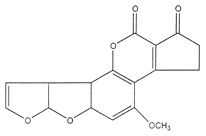ToxicBlackMould
Information about mould and mould disease
Alfatoxins

Alfatoxins are a family of related toxins is produced by the moulds Aspergillus flavus and A. parasiticus, which commonly contaminate food grains and water damaged dwellings. Aspergillus ochraceoroseus, Aspergillus bombycis, Aspergillus pseudotamari , Aspergillus nomius, are all known aflatoxin-producing species. Similarly to the A. flavus and A. parasiticus they can produce produce large quantities of toxins but fortunately are less common in food stock and indoor environment. Their harmful effect on animals and humans (toxicity?) was recognized early due to the significant damages they caused to farm animals. The major effort in isolation and identification of aflatoxins follow the death of more than 100,000 turkeys. The disease is known ad turkey X disease and was caused by turkey feeding on mould contaminated peanut feed. There are four major aflatoxins known as B1, B2, G1, and G2. The harmful and toxic effects on animals and humans was recognised as a significant health problem warranting much research and establishment of firm regulatory guidelines.
Humans are mainly exposed to aflatoxin through consumption food and therefore gastrointestinal symptoms predominate; neuropathy, rashes, memory problems, and joint pain are not commonly reported. The toxins are stable in heath and survive cooking. Many substrates support growth and aflatoxin production by aflatoxigenic moulds. They are most commonly isolated for food ingredients such as nuts, figs, cereals but also tobacco and other common food items.
Alfatoxins – A potent carcinogens
Aflatoxin B1 is one of the most potent carcinogens? known to man and has been linked to a wide variety of human health problems. Aflatoxin B1 is usually the major aflatoxin produced by toxigenic strains of moulds. Apart from B1 alfatoxin over twelve other toxins belonging to this group (e.g. B2a, G2a, M1, M2, P1 and Q1) have been isolated and identified. The aflatoxin poisoning shows delayed toxicity which could be anywhere from eight hours to several days. The main reason for this effect is that they require activation by certain chemcial compounds released during metabolic processes. Alfatoxin carcinogenity is the main reason for much scientific and medical interest into these compounds.
Activated alfatoxin B1 damages DNA and impairs RNA and protein synthesis. Proteins, including receptors and those with important intracellular functions, may also be non-specifically but irreversibly bound by toxins, producing diverse loss of function (e.g., enzyme inactivation). There has been concern about an increased risk of lung and liver cancer among humans chronically exposed to low-level Alfatoxin B1 in grain dust.
A person's chances of contracting cancer are compounded significantly if he/she carries the hepatitis B virus(the virus that causes jaundice
Alfatoxins have been proven to have mitogenic? effects at levels well below clinical toxicity. They role in development of cancer tissues is well known , however respiratory disease or other illnesses from prolonged respiratory exposure has not been found.
Health effects on humans
Animals and humans with high exposures to aflatoxin have seizures. The Malay cases showed widespread edema, with petechial hemorrhages in the white matter.
The diseases related to consumption of alfatoxins are commonly refered to as aflatoxicoses. Acute poisoning by alfatoxins usually results in death. Chronic, long-term, exposure often causes cancer, degradation of the immune system and other “slow” damaging conditions. The liver is suspected to be the primary target organ for damaging effects of alfatoxis. It is believed that kwashiorkor, a severe malnutrition disease, could be a type of pediatric alfatoxin poisoning. Long term exposure to alfatoxins does not usually lead to symptoms of cute aflatoxicosis. The most supectible group are children wchich can develop symptoms such as stunted growth and delayed development.
